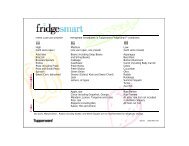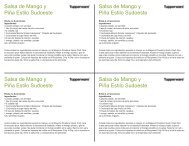Summary Plan Description Booklet
Summary Plan Description Booklet
Summary Plan Description Booklet
You also want an ePaper? Increase the reach of your titles
YUMPU automatically turns print PDFs into web optimized ePapers that Google loves.
B. Waiving the Qualified Joint and Survivor Annuity<br />
If you wish to receive your vested account balance using one of the other options listed in Section II through<br />
IV of this form, you (and, if you are married, your spouse) must waive the Qualified Joint and Survivor<br />
Annuity.You can waive the Qualified Joint and Survivor Annuity by completing a distribution form.You can<br />
obtain this form from the <strong>Plan</strong> Administrator (Employer).After waiving the Qualified Joint and Survivor<br />
Annuity by signing the distribution form, you may receive your vested account balance using one of the<br />
other distribution methods explained below.<br />
C. Financial Effect of a Qualified Joint and Survivor Annuity<br />
As stated above, a Qualified Joint and Survivor Annuity will provide periodic payments to you during your<br />
lifetime and, if you are married, to your spouse after your death.Your spouse will generally receive smaller<br />
periodic payments than you received while you were alive.For example, assume a Participant retires with a<br />
$10,000 vested account balance.A Qualified Joint and Survivor Annuity would provide him or her with the<br />
following payments:<br />
Lifetime Monthly Monthly<br />
Participant Benefit % of Survivor Annuity* Survivor Benefit<br />
$63.40 100% $63.40<br />
$66.30 75% $49.72<br />
$67.30 66.67% $44.86<br />
$69.40 50% $34.70<br />
*These estimates are derived from standard mortality tables using a Participant with a 65-year-old spouse<br />
Beneficiary beginning payments at age 65.To determine the survivor annuity percentage, contact the <strong>Plan</strong><br />
Administrator (usually the Employer).<br />
II. ANNUITY CONTRACT<br />
If the Qualified Joint and Survivor Annuity is properly waived, you may purchase an annuity contract with your<br />
vested account balance.This distribution option allows you to choose the type of annuity contract you wish<br />
to purchase.<br />
A. Annuity Contract Defined<br />
You may use your vested account balance to purchase a term certain annuity, a single life annuity or any<br />
other form of annuity.A term certain annuity would distribute dollars to you and your beneficiary for a<br />
specified number of years.A single life annuity would distribute dollars to you for your lifetime and would<br />
cease distributions after your death.<br />
B. Financial Effect and Tax Consequences of the Annuity<br />
If you elect to use your vested account balance to purchase a single life annuity, you will receive payments as<br />
long as you are alive.For example, a participant who is age 65 with a $10,000 vested account balance will<br />
receive $76.60 per month while he or she is alive.<br />
III. LUMP SUM PAYMENT<br />
If you properly waive the Qualified Joint and Survivor Annuity or if this is a REA Safe Harbor <strong>Plan</strong> and no existing<br />
plan assets are subject to the REA annuity requirements, you may request a single sum payment.<br />
A. Lump Sum Payment Defined<br />
A Lump Sum Payment is the payment of your entire vested account balance.<br />
B. Financial Effect and Tax Consequences of a Lump Sum Payment<br />
Generally a Lump Sum Payment is included in your income and taxed in the year of the distribution.Most<br />
Lump Sum Payments are eligible rollover distributions and would therefore be subject to the 20% withholding<br />
rules unless directly rolled over to another plan or Traditional IRA.See the “Special Tax Notice Regarding<br />
<strong>Plan</strong> Payments” for more information.<br />
IV. INSTALLMENT PAYMENTS<br />
If the Qualified Joint and Survivor Annuity is properly waived or if this is a REA Safe Harbor <strong>Plan</strong>, you may elect<br />
to receive your vested account balance in installment payments.Installment payments for a period of less than<br />
10 years are generally eligible rollover distributions and would therefore be subject to the 20% withholding rules<br />
unless directly rolled over to another plan or Traditional IRA.See the “Special Tax Notice Regarding <strong>Plan</strong><br />
Payments” for more information.<br />
16

















